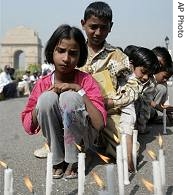2006年VOA标准英语-WHO Reports Progress in Fight Against Tuberculo(在线收听)
By Anjana Pasricha
New Delhi
22 October 2006
 Children infected with tuberculosis light candles at a march to mark World Tuberculosis Day in New Delhi, March 24, 2006 |
||
The World Health Organization says there has been considerable progress in the fight against tuberculosis in South Asia and Indonesia, where the worst TB problems exist. India has the highest number of tuberculosis cases in the world.
-----
For decades, tuberculosis has extracted a heavy toll in India, although the disease is usually easily cured with an inexpensive, six-month treatment of drugs. Nearly two million new patients are stricken with the disease every year in impoverished Indian communities, and one thousand die every day.
But an international panel of health experts that traveled through six Indian states this month to review the world's largest tuberculosis control program says the tide may finally be turning.
World Health Organization officials say the program has prevented at least one million deaths in India from the disease in recent years, and the cure rate has increased dramatically, to more than 80 percent.
But a top international tuberculosis expert and senior member of the mission that reviewed the program, Fabio Luelmo, cautions that combating tuberculosis is a long-term battle.
"You have to maintain this for about 50 years minimum to reduce tuberculosis so it is not a major problem, because no matter what you do, tuberculosis reduces slowly, because a large part of the population is already infected. So it [the program] needs sustainability," said Luelma.
WHO officials say the main battle against tuberculosis is being waged in the five countries of South and Southeast Asia that account for the bulk of the worldwide cases. The five are India, Bangladesh, the Maldives, Burma and Indonesia.
Jay Narain, the director for communicable diseases at the WHO's Southeast Asia office in New Delhi, says all these countries are making progress against the disease, and two - India and Indonesia - are showing particular success.
"Most of the countries are making extremely good progress, said Narain. "I can say categorically that the global progress in TB control is being driven by the progress that is being made in this region, led by India, followed by Indonesia."
The panel of international health experts, which included WHO officials, says the Indian government has expanded coverage of a successful treatment strategy through most of the country, enabling life-saving services and diagnosis to reach millions of people in remote, rural communities.
The strategy is called "directly observed treatment," or DOTS. It simply means that drugs are not handed out to patients themselves. Instead, the patients are asked to take their medicines at the nearest free clinic, three times a week, while a health worker watches.
The reasoning behind this is simple: patients often stop taking medicines as soon as they feel better, but before the disease-causing bacteria are completely killed, which can allow deadlier, drug-resistant forms of bacteria to develop. The health workers make sure patients complete the entire course.
Tuberculosis is one of the world's deadliest infectious diseases. A dramatic upsurge of the disease since the mid-1980's prompted the WHO to declare it a global emergency in 1993.